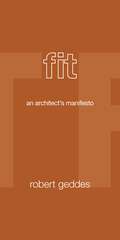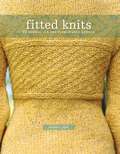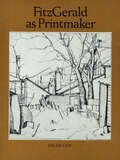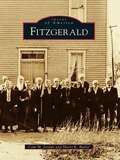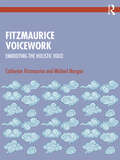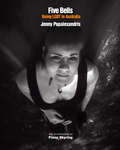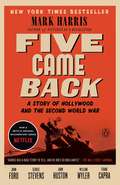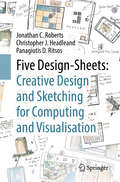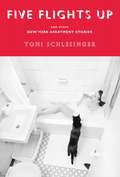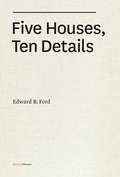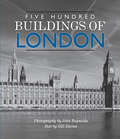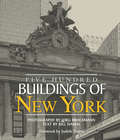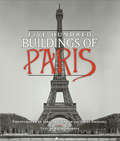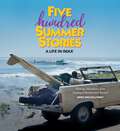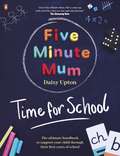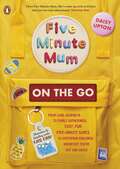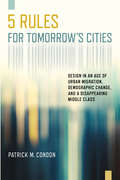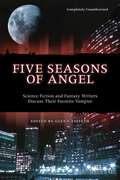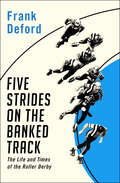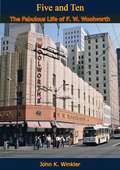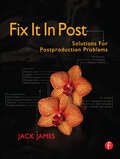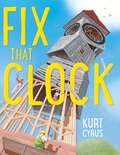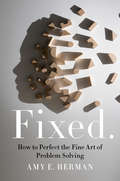- Table View
- List View
Fit: An Architect's Manifesto
by Robert GeddesWhy architecture matters—and how to make it matter moreFit is a book about architecture and society that seeks to fundamentally change how architects and the public think about the task of design. Distinguished architect and urbanist Robert Geddes argues that buildings, landscapes, and cities should be designed to fit: fit the purpose, fit the place, fit future possibilities. Fit replaces old paradigms, such as form follows function, and less is more, by recognizing that the relationship between architecture and society is a true dialogue—dynamic, complex, and, if carried out with knowledge and skill, richly rewarding.With a tip of the hat to John Dewey, Fit explores architecture as we experience it. Geddes starts with questions: Why do we design where we live and work? Why do we not just live in nature, or in chaos? Why does society care about architecture? Why does it really matter? Fit answers these questions through a fresh examination of the basic purposes and elements of architecture—beginning in nature, combining function and expression, and leaving a legacy of form.Lively, charming, and gently persuasive, the book shows brilliant examples of fit: from Thomas Jefferson's University of Virginia and Louis Kahn's Exeter Library to contemporary triumphs such as the Apple Store on New York's Fifth Avenue, Chicago's Millennium Park, and Seattle's Pike Place.Fit is a book for everyone, because we all live in constructions—buildings, landscapes, and, increasingly, cities. It provokes architects and planners, humanists and scientists, civic leaders and citizens to reconsider what is at stake in architecture—and why it delights us.
Fitted Knits
by Stefanie JapelCustomize handknits to fit and flatter your figure Whether you're tall or short, curvy or slender, you deserve clothes that fit you perfectly. Fitted Knits gives you patterns that create well-fitted garments designed to accentuate your positives. You simply knit to your measurements, easily adjusting the pattern so it's tailored to your unique shape. You'll be surprised at how easy it is to add shaping details that ensure a perfect fit for your figure. There is something here to keep you knitting happily the whole year through, from lightweight summer tanks and tees to shrugs, wraps and cardigans perfect for those transitional times, and, of course, warm and cozy sweaters, vests and coats to get you through the cold months. Inside Fitted Knits you'll find: a How to Fit Your Knits guide that shows you exactly how to adjust the patterns in the book to get a perfect fit 25 wearable fashion-inspired knits for all seasons a user-friendly skill level guide so you know what to expect with each pattern an essential information section including a knitting abbreviations key, a knitting needle conversion chart, a helpful Reference Library and a list of great knitting websites No more boxy, shapeless sweaters for you! Pick up your needles today and knit to fit.
Fitter, Happier, Healthier: Discover the strength of your mind and body at home
by Kate FerdinandBecome Fitter, Happier, Healthier with Kate's secrets for harnessing your strength, caring for your mind and making your body feel great from your own home'Eminently relatable. Non-faddy, easy to cook recipes and a well-explained and doable exercise programme' The Times'She aims to encourage body confidence by making exercise enjoyable for everyone' Sunday ExpressExercise has always been important to Kate, for both the physical and mental benefits. Now, she has developed the ultimate guide to taking control of your physical and mental wellbeing in a truly enjoyable way, without the need for fancy expensive equipment or a gym membership.With insights into her personal regime and how she maintains a positive mental attitude, Kate will guide you through how she stays motivated, healthy and happy!Inside this fully-illustrated guide you'll find:· 4 weeks of empowering at-home exercises for you to follow and gradually build up your fitness· Simple step-by-step instructions for upper body, lower body, and full-body HIIT workouts· Warm-up and cool-down exercises to take care of your body's recovery and mobility· 30 simple and healthy recipes for breakfasts, light meals, main meals & snacks to fuel your exercise and boost your energy· Kate's top tips and advice on how she maintains a healthy lifestyle, stays motivated, manages her anxiety and more· Space for you to fill in your goals and weekly meal plansWith Fitter, Happier, Healthier, Kate will show you how to feel great through exercise, nourish your body and maintain a proactive routine from your own home so you can feel motivated, energised and - most importantly - happy.AS SEEN IN THE SUN
FitzGerald as Printmaker: A Catalogue Raisonné of the Frst Complete Exhibition of the Printed Works
by Helen Coy Lionel LeMoine FitzGeraldFitzGerald as Printmaker includes every known print made by the artist, most of them reproduced in actual size. The accompanying commentary describes the prints, the circumstances under which they were made, the artist’s comments about them, and the methods and techniques he used to achieve the effects he wanted. Written in a clear and lively style, and based on meticulous research, FitzGerald as Printmaker is the definitive volume for the appreciation of FitzGerald’s prints, and for much of his other work as well.
Fitzgerald
by Cam M. Jordan Sherri K. ButlerFounded in 1896 by pension attorney P. H. Fitzgerald as a colony for Union veterans escaping the drought-stricken Midwest, Fitzgerald has built on the spirit of unity exhibited by its early Union and Confederate founders. The town produced such notable citizens as Gen. Ray Davis, assistant commandant of the U.S. Marine Corps; U.N. ambassador Morris Abram; author Frances Mayes; Chief Justice Norman Fletcher; and folk artist Ulysses Davis. The inherent sense of citizen investment in the community led Fitzgerald to be dubbed "the Recruiting Colossus from Nowhere" by the Wall Street Journal after some 40 industries choose Fitzgerald as home. This is a story of pioneer vision and migration, of hewing a town from pine barrens, and of the reuniting of America.
Fitzmaurice Voicework: Embodying the Holistic Voice
by Michael Morgan Catherine FitzmauriceFitzmaurice Voicework: Embodying the Holistic Voice is the ultimate guide to a world-renowned voice approach for discovering and developing the voice's full expressive potential and healthy use. Catherine Fitzmaurice, the originator of the Fitzmaurice Voicework approach, and Michael Morgan bring together over 60 years of original, class-tested exercises and concepts. Detailed instructions, anecdotes, and visuals are used to create an immersive, student-centered learning experience. The book rethinks short- and long-term tensions, mental barriers, and stage fright, providing self-empowering and compassionate ways to enhance vocal abilities for clearer communication, more vocal variety, and meeting vocal performance demands. The authors describe a voice technology that holistically strengthens the speaker's ability to synthesize sensations, emotions, and reflexes with mental decisions. This is done through exercises that elicit the power of the autonomic and central nervous systems through a multi-layered integrative mind/body/breath approach and introducing the innovative Destructuring/Restructuring process. Fitzmaurice Voicework is about creating meaning that considers one's entire humanity.Acting students and voice teachers will find this insightful and unique volume to be an invaluable resource. It also helps actors, voiceover artists, singers, public speakers, and anybody else develop their expressive and communication skills. It's for people who desire to speak more clearly, spontaneously, authentically, and decisively.
Five Bells
by Jenny Papalexandris Fiona SkyringIn a country known as one of the most queer-friendly nations in the world, most Australians support LGBTI rights, federal laws protect queer people from discrimination, transgender Australians are recognized legally as their preferred gender, and the renown of Sydney's Gay and Lesbian Mardi Gras Festival has reached across its borders.The eight visual narratives that make up award-winning Australian photographer Jenny Papalexandris's intimate and thematically rich Five Bells offers a celebration of queer life, giving the reader a visual portrait of everyday life among queer-identifying people, from joyful images of weddings and family gatherings to more contemplative portraits of rural youth and asylum seekers. In so doing, the book presents a series of neither caricatures nor stereotypes but of individuals-active agents in the universal quest for happiness, intimacy, fulfillment, respect, and a sense of belonging. This is the human face of the queer community in Australia, and these beautifully crafted and life-affirming photographs, in black-and-white and in color, show us the personal and psychological landscape of what it means to be part of a community that is as vibrant as it is diverse.
Five Came Back: A Story Of Hollywood And The Second World War
by Mark HarrisIn Pictures at a Revolution, Mark Harris turned the story of the five movies nominated for Best Picture in 1967 into a landmark work of cultural history, a book about the transformation of an art form and the larger social shift it signified. In Five Came Back, he achieves something larger and even more remarkable, giving us the untold story of how Hollywood changed World War II, and how World War II changed Hollywood, through the prism of five film directors caught up in the war: John Ford, William Wyler, John Huston, Frank Capra, and George Stevens. It was the best of times and the worst of times for Hollywood before the war. The box office was booming, and the studios' control of talent and distribution was as airtight as could be hoped. But the industry's relationship with Washington was decidedly uneasy--hearings and investigations into allegations of corruption and racketeering were multiplying, and hanging in the air was the insinuation that the business was too foreign, too Jewish, too "un-American" in its values and causes. Could an industry this powerful in shaping America's mind-set really be left in the hands of this crew? Following Pearl Harbor, Hollywood had the chance to prove its critics wrong and did so with vigor, turning its talents and its business over to the war effort to an unprecedented extent. No industry professionals played a bigger role in the war than America's most legendary directors: Ford, Wyler, Huston, Capra, and Stevens. Between them they were on the scene of almost every major moment of America's war, and in every branch of service--army, navy, and air force; Atlantic and Pacific; from Midway to North Africa; from Normandy to the fall of Paris and the liberation of the Nazi death camps; to the shaping of the message out of Washington, D.C. As it did for so many others, World War II divided the lives of these men into before and after, to an extent that has not been adequately understood. In a larger sense--even less well understood--the war divided the history of Hollywood into before and after as well. Harris reckons with that transformation on a human level--through five unforgettable lives--and on the level of the industry and the country as a whole. Like these five men, Hollywood too, and indeed all of America, came back from the war having grown up more than a little.From the Trade Paperback edition.
Five Design-Sheets: Creative Design and Sketching for Computing and Visualisation
by Christopher J. Headleand Jonathan C. Roberts Panagiotis D. RitsosThis book describes a structured sketching methodology to help you create alternative design ideas and sketch them on paper. The Five Design-Sheet method acts as a check-list of tasks, to help you think through the problem, create new ideas and to reflect upon the suitability of each idea. To complement the FdS method, we present practical sketching techniques, discuss problem solving, consider professional and ethical issues of designing interfaces, and work through many examples.Five Design-Sheets: Creative Design and Sketching for Computing and Visualization is useful for designers of computer interfaces, or researchers needing to explore alternative solutions in any field. It is written for anyone who is studying on a computing course and needs to design a computing-interface or create a well-structured design chapter for their dissertation, for example. We do acknowledge that throughout this book we focus on the creation of interactive software tools, and use the case study of building data-visualization tools. We have however, tried to keep the techniques general enough such that it is beneficial for a wide range of people, with different challenges and different situations, and for different applications.
Five Flights Up: AAnd Other New York Apartment Stories
by Toni SchlesingerA flop house, a pumping station, a maid's room, a homeless center, a former brothel, a Richard Meier building, a circus trailer, a sail boat, a skyscraper, buildings named Esther and Loraine—just a few of the places New Yorkers call home. For the past eight years writer Toni Schlesinger has been bringing us these "conversation places" in her weekly column in the Village Voice. Through her incisive questioning, original writing, and comic parallel reveries, Schlesinger creates miniature documentaries on the lives, passions, hopes, and heartbreaks of many of New York City's millions
Five Houses, Ten Details
by Edward R. FordEdward Ford's forty years of practicing and teaching architecture have focused on one area: the architectural detail. Yet, despite two hugely influential books (The Details of Modern Architecture, volumes 1 and 2), numerous articles, and lectures given from Vancouver to Vienna, there are two questions Ford has, remarkably, never answered: "What is a detail?" and more importantly, "What is a good detail?" Ford is an architect as well as a writer, so it is not surprising that rather than answering these questions in a third book, he spent six years on the design and construction of a house. Building it was not an exercise in the application of ideas about detail; it was, rather, a mechanism for answering those two simple questions.
Five Hundred Buildings of London
by John Reynolds Gill DaviesFive hundred stunning duotone photographs showcase the finest, most majestic, and interesting examples of architecture in one of the world's most beloved citiesThe greatest buildings, monuments, and structures of London come to life in these inspiring, neighborhood-by-neighborhood photographic tours. Each building is featured in a rich, fine-resolution duotone photograph. Information including the building's name, its address and location, and year of completion or renovation is included underneath the image. A brief description of each building, which highlights its distinctive features and places it in historical context, is included at the back of the book.
Five Hundred Buildings of New York
by Bill Harris Jorg BrockmannFive hundred stunning duotone photographs showcase the finest, most majestic, and interesting examples of architecture in one of the world's most beloved citiesThe greatest buildings, monuments, and structures of New York come to life in these inspiring, neighborhood-by-neighborhood photographic tours. Each building is featured in a rich, fine-resolution duotone photograph. Information including the building's name, its address and location, and year of completion or renovation is included underneath the image. A brief description of each building, which highlights its distinctive features and places it in historical context, is included at the back of the book.
Five Hundred Buildings of Paris
by Jorg Brockmann Kathy Borrus James DriscollFive hundred stunning duotone photographs showcase the finest, most majestic, and interesting examples of architecture in one of the world's most beloved citiesThe greatest buildings, monuments, and structures of Paris come to life in these inspiring, neighborhood-by-neighborhood photographic tours. Each building is featured in a rich, fine-resolution duotone photograph. Information including the building's name, its address and location, and year of completion or renovation is included underneath the image. A brief description of each building, which highlights its distinctive features and places it in historical context, is included at the back of the book.
Five Hundred Summer Stories: A Lifetime of Adventures of a Surfer and Filmmaker
by Greg MacGillivrayThe filmmaker of the surfing documentary Five Summer Stories and pioneer of the IMAX format tells stories from his adventurous life and groundbreaking career in Hollywood and beyond. Greg MacGillivray is a man with stories. Stories of being a surfer kid in California, and making his first movie at the age of 13; of his early days as a filmmaker, creating iconic surfing documentaries such as the cult classic 5 Summer Stories, with his partner in crime, Jim Freeman; of his years in Hollywood, working in Hollywood with such legends such as Stanley Kubrick (on The Shining, no less); and of his work pioneering the 70mm IMAX film format, creating some of the most spectacular, groundbreaking cinematography celebrating the natural world. There are stories of almost dying in New Guinea, flying into eyes of hurricanes, the perils of shooting in the USSR, and how filming Mount Everest changed his life. Greg MacGillivray has led a life like no other, - and for the first time, he&’s telling his story. In this fascinating memoir, Greg chronicles his personal journey as an artist, a self-made filmmaker, a father, and an entrepreneur at the head of the most successful documentary production company in history. It is also a story about MacGillivray&’s deep commitment to family, to ocean conservation, and to raising awareness about the importance of protecting our natural heritage for generations to come. Contributions by legendary surfers Gerry Lopez and Bill Hamilton, and filmmakers such as Stephen Judson and Brad Ohlund, plus 40 QR codes to extraordinary film clips, add give even more depth and perspective to this amazing journey. Greg&’s compelling stories of adventure, surfing, love, loss, inspiration, conservation, and filmmaking give you a front seat to an extraordinary life - and, just like his IMAX movies, makes you feel as if you are there. EXCLUSIVE VIDEOS: Includes 40 QR codes linked to rare, incredible videos that bring Greg MacGillvray&’s stories to life. BEHIND-THE-SCENES SECRETS: Learn the history of the IMAX film format, and how filmmakers achieve an immersive and awe-inspiring visual experience. FROM SURFER TO MOVIE LEGEND: Follow the journey of a man who went from a teenage surfer to the most successful documentary filmmaker in history with hundreds of amazing escapades and achievements in between.
Five Minute Mum: Easy, fun five-minute games to support Reception and Key Stage 1 children through their first years at school (Five Minute Mum)
by Daisy UptonIdeal for early years to KS1 children who are starting or are already at Reception and KS1 primary school. Phonics! Number sentences! Reading schemes! School uniforms! Daisy Upton has two children, and used to be a teaching assistant, so is more than familiar with the reality of being a parent. This book is packed full of games and activities to help children feel confident and excited about learning. They -and you! - will get help with letters, numbers and everything in between.Daisy's games only take five minutes to set up and five minutes to tidy up you can support them at home without wanting to bang your head on the kitchen table. 'I love Five Minute Mum - she's come up with games that are fun and educational' The Unmumsy MumAlso available:Five Minute Mum: Give Me FiveFive Minute Mum: On the Go
Five Minute Mum: From long journeys to family gatherings, easy, fun five-minute games to entertain children whenever you're out and about (Five Minute Mum)
by Daisy UptonIf you've ever taken a child (or sat near one) on public transport - you know how important this book is. Five Minute Mum: On the Go is the ultimate companion to any journey, staycation or holiday: 80 games to keep little ones happily - and quietly! - occupied when you're out and about. Also featuring games suitable for big groups on holidays or at parties, this is endless fun for kids, and sanity saving for their grown ups!
Five Rules for Tomorrow's Cities: Design in an Age of Urban Migration, Demographic Change, and a Disappearing Middle Class
by Patrick M. CondonAs urban designers respond to the critical issue of climate change they must also address three cresting cultural waves: the worldwide rural-to-urban migration; the collapse of global fertility rates; and the disappearance of the middle class. In Five Rules for Tomorrow's Cities, planning and design expert Patrick Condon offers five rules to help urban designers assimilate these interconnected changes into their work: (1) See the City as a System; (2) Recognize Patterns in the Urban Environment; (3) Apply Lighter, Greener, Smarter Infrastructure; (4) Strengthen Social and Economic Urban Resilience; and (5) Adapt to Shifts in Jobs, Retail, and Wages. Five Rules for Tomorrow's Cities provides grounded and financially feasible design examples for tomorrow's sustainable cities, and the design tools needed to achieve them.
Five Seasons Of Angel: Science Fiction and Fantasy Writers Discuss Their Favorite Vampire
by Glenn YeffethThe constellation of characters and themes created in Angel, the popular Buffy the Vampire Slayer spin-off, are explored in this collection of essays. A vampire author, a sex expert, a TV critic, a science fiction novelist, and Buffy writer Nancy Holder provide essays examining the different issues relating to the series, including Angelus as the prototypical high school bully, Angel as victim, Wesley's many transformations, how Spike fits into Angel, the takeover of Wolfram & Hart, and Lindsey's moral center.
Five Strides on the Banked Track: The Life and Times of the Roller Derby
by Frank DefordIllustrated with photographs by Walter Iooss Jr.: Iconic sportswriter and commentator Frank Deford&’s first book brings to life one of America&’s most thrilling—and misunderstood—sports entertainments, the Roller Derby, from its birth during the Great Depression to it second ascendancy in the late 1960sIn Five Strides on the Banked Track, distinguished sports journalist Frank Deford opens a fascinating window on this exhilarating entertainment that operates according to its own set of unique rules—both on and off the track.The Derby began as an idea on a tablecloth in 1935 by Leo Seltzer. From its Great Depression roots—when young skaters would run away to join the Roller Derby in the same way one might run away to join the circus—through its prewar heyday, postwar decline, and ultimate rise to superstardom in the 1960s, Deford sweeps us along on an unforgettable journey. He brings together the players, the fans, the promoters, and the celebrities. He shares the exploits of Bay Bomber legend Charlie O&’Connell, superstar Joanie Weston, and beloved villain Ann Calvello, with her dyed blue hair, who would ultimately go on to compete in Roller Derby in seven separate decades. Deford vividly captures the excitement of a sport Variety called &“cathartic, dramatic, fast-paced, and classic as a John Wayne movie.&” From the idolatry of the fans to the loneliness of the open road to the hard-charging frenzy of the arena, this is a rare glimpse into a uniquely American spectator sport that continues to reinvent and resurrect itself today.This definitive new edition includes a foreword by Jerry Seltzer and an introduction by Frank Deford.
Five and Ten: The Fabulous Life of F. W. Woolworth (Select Bibliographies Reprint Ser.)
by John K. WinklerThis book, first published in 1940, is the unmissable biography of Frank Winfield Woolworth (1852-1919), the American entrepreneur behind the F. W. Woolworth Company and the operator of variety stores known as “Five-and-Dimes”. He was also the first to use self-service display cases, so customers could examine what they wanted to buy without the help of a sales clerk.Woolworth founded an international financial empire with a short lease on a tiny store, a couple of gross of tin cans and a simple but revolutionary idea. Woolworth grew up a poor farm boy who tended his father’s cows barefoot, but he followed the great American dream by parlaying native ingenuity, business sense, and understanding of people into a huge fortune and establishing an institution that became a familiar part of America’s way of life.
Fix It In Post: Solutions for Postproduction Problems
by Jack JamesThis book provides an array of concise solutions to the wide variety of problems that are faced by postproduction artists in the post process. With an application-agnostic approach, it gives proven, step-by-step methods to solving the most frequently encountered postproduction problems. Also included is access to a free, password-protected website that features application-specific resolutions to the problems presented, with fixes for working in Apple's Final Cut Studio suite, Avid's Media Composer, Adobe Premiere Pro, as well as other applications. Lessons are enhanced through eye-catching 4 color illustrations throughout. Solutions are provided for common audio, video, digital, editorial, color, timing and compositing problems, such as, but not limited to:* automated dialogue replacement, adjusting sync, and correcting pitch * turning SD into HD (and vice-versa) and restoration of old film for video* removing duplicate frames, repairing corrupt frames, and anti-aliasing * maintaining continuity, removing soft cuts, and troubleshooting timecodes* adding vignettes, removing color casts, and legalizing color* speeding shots up or slowing shots down, and smoothing timelapse* reframing shots, sky replacement, and object addition or removalThe book is presented in a "cookbook" format, allowing you to reference your exact problem in the TOC or index, go to that section, and immediately implement the solution featured.
Fix That Clock
by Kurt Cyrus2019 Kirkus Best Picture Book of the YearA construction crew rebuilds a rickety old clock tower that has become home to wild animals in this picture book for fans of Sheep in a Jeep and Goodnight, Goodnight, Construction Site. An underlying message of cooperation and conservation drives this rollicking introduction to counting and shapes. The old clock tower used to stand tall and proud. Now, it&’s rusty, dusty, moldy, musty. A construction team decides to turn zigzags into squares and get the clock chiming again. But wait: What will happen to all the animals who have made this dilapidated clock their home? Nothing can&’t be fixed and everyone is welcome in Fix That Clock, a celebration of hard work, compassion, and collaboration.
Fixed.: How to Perfect the Fine Art of Problem Solving
by Amy E HermanWith Amy Herman’s Fixed., we now have access to what the FBI, NATO, the State Department, Interpol, Scotland Yard, and many more organizations and their leaders have been using to solve their most intractable problems.Demonstrating a powerful paradigm shift for finding solutions, Herman teaches us to see things differently, using art to challenge our default thinking and open up possibilities otherwise overlooked. Her unexpected, insightful, and often delightful methodology is sought after by leaders and professionals for whom failure is catastrophic. Luckily for us, these tactics work— no matter the problem’s scale or complexity. And we don’t need an art degree or previous knowledge about art to benefit from her approach, only a willingness to open our eyes and our minds. Yes, things go wrong all the time. What matters most is what we do to fix them.
Fixie For Life: Urban Fixed-Gear Style and Culture
by Chris NaylorThis book celebrates the art and craft of one-gear bikes with stunning photos and inspirational quotes. Fixies and single-speeds are the ride of choice for hipsters, tricksters and hardmen alike – bare-bones bikes that can be dressed up or stripped down; simple machines that have inspired a diverse, inventive culture and innovative designs.
